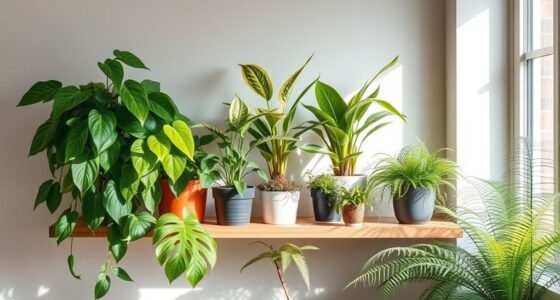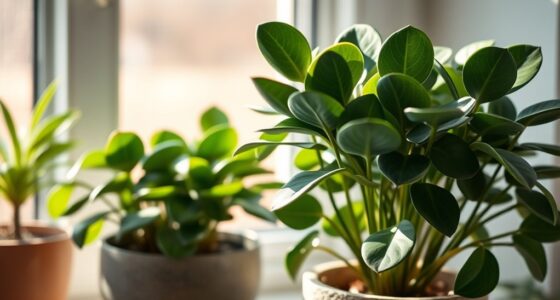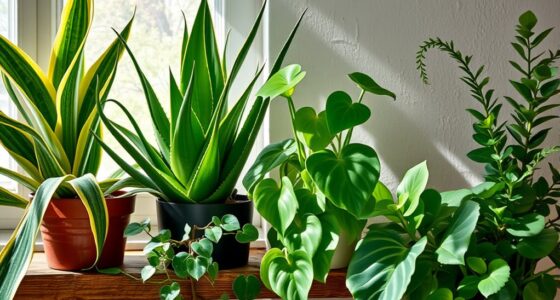To keep your tillandsia happy without soil, give it bright, indirect light and good air circulation. Water it by soaking in water for 20-30 minutes every 1-2 weeks, then shake off excess moisture and let it dry completely. Avoid overwatering, which can cause rot. Make certain your plant isn’t in a dark or stuffy spot for long periods. For more tips on thriving air plants, explore how to care for and display them creatively.
Key Takeaways
- Provide bright, indirect sunlight to promote healthy growth and avoid leaf burn.
- Soak your air plants in water for 20-30 minutes every 1-2 weeks, then dry thoroughly.
- Ensure good air circulation around the plants to prevent rot and encourage drying.
- Avoid overwatering; let the plant dry completely between waterings.
- Mount or display on decorative surfaces like driftwood or shells for optimal airflow and aesthetic appeal.

Air plants are unique and low-maintenance greenery that thrive with minimal care, making them a popular choice for both beginners and seasoned plant enthusiasts. Their ability to grow without soil and adapt to various environments makes them a versatile addition to your home or office. To keep your Tillandsia happy, understanding how to care for them, including air plant propagation and creative air plant display ideas, is essential.
When it comes to air plant propagation, you’ll find that it’s a straightforward process that allows you to multiply your collection naturally. Most air plants produce offsets, or pups, which grow at the base of the mother plant. You can gently separate these pups once they’re about one-third to half the size of the mother plant. Carefully removing and planting these pups in new containers or mounting them on different surfaces allows your collection to flourish. Remember, patience is key—these pups will take time to grow, but with proper care, they can develop into full-sized plants on their own. Propagating air plants not only expands your greenery but also deepens your understanding of their growth habits.
Propagating air plants is simple—separate pups at a third to half the size and watch your collection grow naturally.
When considering air plant display ideas, think outside the traditional pot. Since these plants don’t need soil, you’re free to showcase them in creative ways. Use driftwood, seashells, or decorative stones as mounting surfaces, which adds a natural touch to your display. You can also hang them from glass terrariums or attach them to wall-mounted frames for a striking visual effect. Incorporate aesthetic elements like fairy lights, colorful beads, or miniature figurines to create eye-catching arrangements that reflect your style. Clusters of multiple air plants in a single display can create a lush, textured look, perfect for tabletops or wall art. Just ensure your display allows for good air circulation and easy access for watering. Additionally, understanding the importance of proper storage conditions can help prolong the health and vibrancy of your air plants.
Caring for your air plants involves more than just display—remember they need bright, indirect sunlight, and should be soaked in water for about 20-30 minutes every 1-2 weeks. After watering, shake off excess moisture and let them dry completely before placing them back into their display. Proper air circulation is vital to prevent rot, so avoid keeping them in overly humid or enclosed spaces. By embracing creative display ideas and practicing regular propagation, you’ll not only enhance your decor but also deepen your connection with these fascinating plants. Their low-maintenance nature means you can enjoy their beauty with minimal effort, making them an ideal green addition to any space.
Frequently Asked Questions
How Often Should I Water My Air Plants During Winter?
You wonder about watering frequency during winter care for your air plants. In winter, you should water your Tillandsia less often, roughly once every 2-3 weeks, since they need less moisture in the cooler months. Make sure to soak or mist them thoroughly and let them dry completely between waterings. Adjust based on your home’s humidity and your plant’s appearance, ensuring they stay healthy without overwatering.
Can Air Plants Survive in Low Humidity Environments?
In low humidity environments, your air plants face humidity challenges that can make their survival tougher. However, they’re quite adaptable and can survive with proper care. To support air plant adaptation, you should increase air circulation and mist them more frequently, especially during dry seasons. Using a humidity tray or placing them near a humidifier can also help, ensuring they get the moisture they need to thrive despite the low humidity.
What Are Common Pests That Affect Air Plants?
They say, “A stitch in time saves nine,” and that’s true for pests on your air plants. Common pests like mealybugs, scale insects, and spider mites can weaken or damage your plants. To prevent pests, inspect your plants regularly and keep them healthy with proper watering and air circulation. Pest prevention is key—early detection stops an infestation before it spreads, ensuring your air plants stay vibrant and thriving.
How Do I Revive a Dried-Out Air Plant?
To revive dried air plants, start troubleshooting withering tillandsia by gently soaking it in water for about 30 minutes. After soaking, shake off excess water and place it in a bright, indirect light spot. make certain of good air circulation and avoid overwatering. Reviving dried airplants involves proper hydration and care, helping them regain their health. Regularly monitor moisture levels to prevent future issues with drying out.
Are There Specific Fertilizers Suitable for Air Plants?
Think of your air plant as a tiny, vibrant sun waiting to shine. When choosing fertilizer, look for one specifically formulated for air plant nutrients, often labeled as bromeliad or Tillandsia fertilizer. You should apply it sparingly—about once a month—by misting or soaking. Proper fertilizer application helps your air plant thrive, ensuring it stays healthy, colorful, and full of life, like a miniature sun glowing with energy.
Conclusion
Now that you know how to care for your tillandsia, keeping it happy and healthy isn’t complicated. Just remember to give it enough light, occasional water, and good airflow. Isn’t it satisfying to see your air plant thrive without soil? With a little attention and love, your air plant can become a stunning, low-maintenance addition to your space. So go ahead, enjoy nurturing your tillandsia and watch it flourish!









